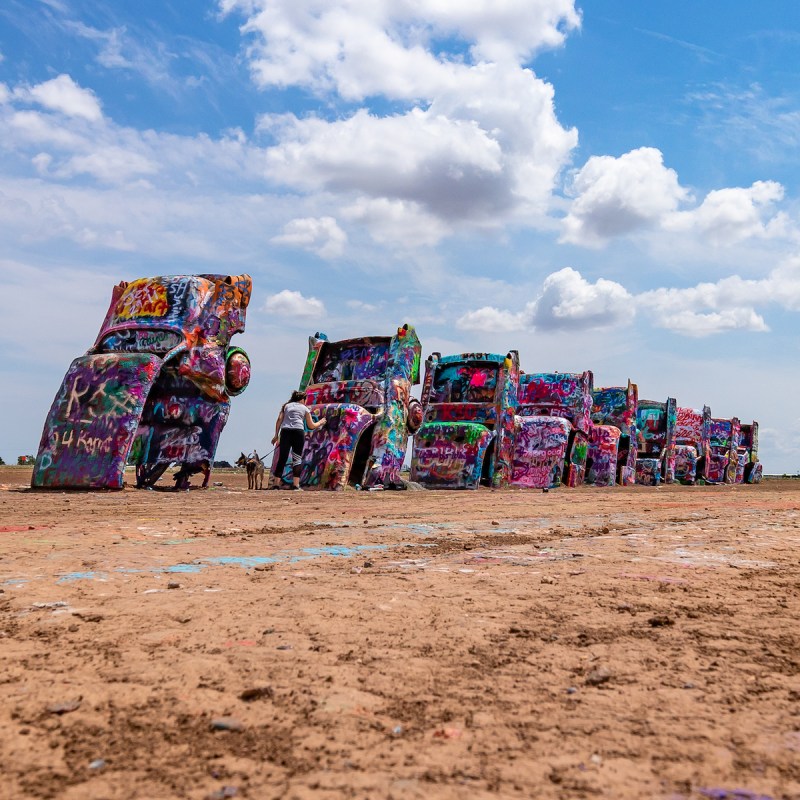
Depending on how you feel about cars, these boundary-pushing art installations are an ode to the road or censure of our culture’s obsession with automobiles. All are free attractions worth pulling over for. This list will steer you in the right direction.
Videos by TravelAwaits

Cadillac Ranch, Texas
Cadillac Ranch is a rite of passage for anyone traveling the Mother Road (Route 66). Make sure you are playing Bruce Springsteen’s famous song when you arrive. And consider leaving a little bit of yourself behind.
In 1974, just west of Amarillo, Ant Farm, a collective of San Francisco creatives, planted 10 Cadillacs in a ruler-straight line. “A bumper crop,” some wit remarked. An apt description as the installation has spawned many other motor-inspired installations that came afterward.
Ant Farm members drove in Cadillacs ranging from a 1949 Club Sedan to a 1963 Sedan de Ville. They half-buried the cars nose-in, with their tail fins poking out at uniform 52‐degree angles. Whether a tall tale or true, the angle was said to replicate the pyramids at Giza, each car showcased one step in the evolution of the tail fin from 1949 to 1963. Owning a Cadillac was symbolic of success, so burying them in a paddock pointed out the absurdity of consumerism.
Oil baron and banker Stanley Marsh 3 owned the land and financed the project. Quite eccentric, he kept a pet lion and dropped water balloons from his 12th-floor office window. He once said, “Art is a legalized form of insanity, and I do it very well.”
Vandals soon ripped off the tail fins, hubcaps, chrome, and doors. Graffiti artists had a field day. To Caddy lovers, it was sacrilege, but to Marsh, it was art. He believed the installation looked better every year. When Cadillac Ranch needed to be moved because of the encroaching city, he demanded the surrounding trash go with it.
Nearly 50 years later, people still get their artistic kicks on Route 66. Hop out with a spray can and do your best or worst at decorating the car carcasses. Whether you create a masterpiece or tag your name, the next carload of spray can-totting tourists will obliterate your efforts. Such is art.

Carhenge, Nebraska
From the Pyramids of Gisa to Stonehenge, car sculptures give ancient ruins a run for their money. Carhenge is a replica of Britain’s ancient Stonehenge formed from 38 classic cars from the 1950s and 60s. The classic cars are sprayed gray to replicate the prehistoric stone circle and are found in a field north of Alliance along Highway 87.
Creation is all about combining two little ideas that nobody thought of combining — and uniting them in a stroke of genius. Jim Reinders had visited Cadillac Ranch. He also worked in Britain for seven years, where he became fascinated by Stonehenge. When Reinder’s father, Herman, died in 1982 in Nebraska, he proposed building him a memorial.
The building of Carhenge came in 1987 during a family reunion. Jim’s father had loved classic cars, and Carhenge was built on his property. Jim’s clan of 35-strong dug holes and wedged the vehicles into position in work that involved a lot of blood, sweat, and beers. Reinders also said in an interview, “Stonehenge took 1,600 years to build; Carhenge took six days as we relented and used a backhoe and forklift.”
Some cars stood upright as if dropped bumper-first from the heavens. Others were welded on top, creating lintels (horizontal blocks) across the vertical supports. A 1962 Caddy became the heel stone, Stonehenge’s plinth aligned with the summer solstice sunrise. Reinders, an engineer, ensured the car circle was the same dimensions as Stonehenge. Automobiles are not a dissimilar size to the original stones. The family held a dedication on the summer solstice in 1987, mimicking ancient lore. They feasted and burned an outhouse in a ceremonial sacrifice.
Some disgruntled citizens viewed Carhenge as a junkyard unworthy of their tidy town. But most changed their tune as the tourist dollars flooded in. Carhenge attracts 80,000 tourists a year, making it one of America’s most popular roadside attractions.

International Car Forest Of The Last Church, Nevada
According to artist Chad Song in his TEDx talk, this group of planted cars, more commonly known as Junk Car Forest, was an attempt to break a world record. Carhenge comprises 38 cars; Junk Car Forest has 40. Michael “Mark” Rippie came up with the idea and owned the 80 acres of land next to Highway 95. Work began in 2002 using a backhoe to “plant” the vehicles, and artwork continued for a decade. There are similarities with Cadillac Ranch as the vehicles jut out from the ground. But as this is in the Mojave Desert, they appear no stranger than the surrounding Dr. Seuss-like Joshua trees.
Song and other artists painted the cars with murals of such artistic merit few visitors are tempted to paint over them. Junk Car Forest is on the outskirts of the near-ghost town of Goldfield, so it feels like a desert graveyard. Strange apparitions include a limo jutting over a 1950s-style ice-cream van and school buses rammed into the earth casting towering shadows. Huffington Post described Junk Car Forest as “a set of rotting Hot Wheels for the gods.” And fashion designer Stella McCartney (daughter of Paul) used the scene for a surreal fashion video she titled Uncanny Valley.

Urban Jam, Miami
Can a parking garage be a work of art? In Miami’s Design District, it can. Spanish firm Clavel Arquitectos was one of the architectural firms invited to spruce up the sides of a seven-story concrete cast museum garage. It created Urban Jam by suspending 45 gravity-defying classic car bodies in metallic gold and silver from the side of the museum garage. Cars are bolted to the exterior wall as if they are gridlocked traffic or a game of Tetris. Manuel Clavel of Clavel Arquitectos explained his desire to make a bad commute more bearable by transforming a garage, a driver’s destination, into a happier place.
Clavel was inspired by the mind-bending Christopher Nolan movie, Inception. If you missed the film, see the concept in these dreamscapes. Urban Jam has won a string of design awards. From inside the garage, patrons can see the undersides of each vehicle, while at night, the taillights and headlights light up. Concepts of our over-dependence on cars and traffic jams may have inspired the design, but ironically the parking garage adds to congestion as a destination for 800 vehicles.
Robert Fielding, Australian Outback
The shells of abandoned cars are a common sight in the Australian Outback. If the wrecks told stories, they would be of accidents or breakdowns and drivers waiting for hours or even days for help. Indigenous artist Robert Fielding turns these statements of despair into works of art. He paints the cars he finds abandoned by his community in Aboriginal designs with reflective materials before filling them with lit candles and capturing these ghostly images with long exposure photography. The vehicles spring to life in an eerie fashion. To see his creations, you would need to drive through the Anangu Pitjantjatjara Yankunytjatjara (APY for short): a 39,633-square mile Aboriginal local government area in the remote northwest corner of South Australia. If you have no plans to travel that far, you can see his photographs in this exhibition.

The Trans Am Totem, Vancouver
Artist Marcus Bowcott’s Trans Am Totem stands at Vancouver’s Quebec Street and Milross Avenue intersection. The “totem” alludes to Vancouver’s First Nations legacy. The site was once tidal flats and forests before heavy industry and major roads irrevocably changed the landscape. The 33-foot-tall, 25,000-pound artwork comprises a Pontiac Trans Am, a BMW 7 Series, a Honda Civic, a Volkswagen Mk1 Cabriolet, and a Mercedes Benz. Bowcott stacked the car wrecks on an old-growth 150-year-old cedar tree. Bowcott said, “Automobiles are a manufactured want and symbol of extremes: practicality and luxury, necessity and waste. We see this in the muscular Trans Am, the comfortable BMW, and the workhorse Civic.” Bowcott’s sculpture questions the cycle of production and consumption. Drivers on the busy road below and the thousands of SkyTrain riders crossing the viaduct cannot help but see his bold message.

The Tower Of Klythie, Berlin
The New York Times described Chamberlain as the artist who almost single-handedly gave automotive metal a place in the history of sculpture. From 1959 onward, he concentrated on sculptures built out of crushed automobile parts, twisting and welding them into monumental shapes. Chamberlain loved the automobile’s brilliant commercial colors and flashy metallic surfaces. Some art critics saw his work as a criticism of American consumerism. Others believe he used old cars because they were cheap, abundant, and a joy to collect.
One of his most monumental works is the Tower of Klythie, a tower of crushed car bodies dominating The Q’s atrium, a luxury shopping arcade in Berlin. Shoppers heading upwards on the escalators look out at the rippled layers of colorful steel at his Jack and the Giant Beanstalk-like column. Chamberlain’s work is found in permanent collections worldwide. But Chamberlain’s influences take us back to Cadillac Ranch. Until the mid-1970s, Chamberlain assembled his auto sculptures on the ranch of collector Stanley Marsh in Amarillo, Texas. Those car wheels keep turning.
Pro Tip: See a permanent collection of Chamberlain’s automobile sculptures in Dia: Beacon in upstate New York.
